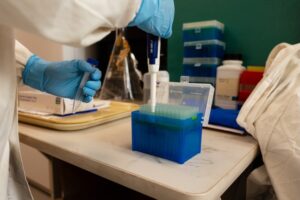An Electrifying Breakthrough
Cleaning and processing wastewater is vitally important to keeping a community safe, but it is also energetically expensive. Every year, wastewater treatment plants across the United States use over 30 terawatt-hours of electricity—enough to power the state of California for more than 10 months.
But what if wastewater could power its own treatment plants?
“The dream of all environmental engineers is a world free of waste and pollution, and the best way to eliminate waste is to reuse it as a resource,” said Qiang He, a professor in the Department of Civil and Environmental Engineering (CEE).
For the past 15 years, He’s research group has been studying methanogenic microbial communities, which convert organic waste into methane—the main component of natural gas.
“These microorganisms can grow by producing renewable energy from our waste in a self-sustained process,” said He. “It is quite remarkable.”

Methanogenic communities are made of two types of microbes: one that can break down organic waste into molecular building blocks and a partner that uses those molecules to produce methane. Methanogenesis is usually limited by the fragile, complex relationship between these species.
Fortunately, He’s team recently made a breakthrough that will make the methanogenic community more robust and easier than ever to create.
After successfully piloting their new method during a UT Global Energy Ecosystems (GE2) grant, He’s team secured a $760,000 award from the National Science Foundation’s Division of Chemical, Bioengineering, Environmental and Transport Systems (CBET) program to perfect the protocol. The funding will be evenly split between He’s group at the University of Tennessee and the laboratory of his co-principal investigator, Professor Heyang Yuan of Temple University.
“This project may serve as the foundation for strategies that significantly enhance the sustainable production of methane from waste, contributing to the goal of a global circular economy,” He said.
Flipping the Switch on Methane Production
He’s group has been working with a common methanogenic system that pairs an eletroactive bacterial species, which releases electrons as it breaks down organic waste, with an electrotrophic species that takes in electrons and uses their energy to create methane. He has conducted much of this research in tandem with Yuan, an expert in electrochemical processes.
Since the methanogens consume electrons for energy, their growth can be encouraged by applying constant cathode conditions to the growth medium. Unfortunately, that makes it harder to co-enrich the electron-generating bacteria.
He’s team reasoned that by regularly alternating the electrode’s polarity—swapping it from cathode to anode and back—they could efficiently select for both microbial species at the same time.


They successfully piloted this novel strategy earlier this year with funding from CBET, a Temple University grant, and UT’s GE2 program.
Jointly funded by UT’s Office of Research Innovation and Economic Development (ORIED) and Institute for a Secure and Sustainable Environment (ISSE), GE2 supports the development of innovative, sustainable energy technology. He and Yuan’s methanogenic community research is the first GE2 project that has gone on to receive federal funding.
“The GE2 grant is tremendously valuable for the support of novel but risky research ideas like this one,” He said. “The preliminary results and analyses we collected during the GE2 were instrumental to creating our NSF grant proposal.”
Cultivating Methanogens and Microbiologists
In addition to cultivating methanogenic communities, He is committed to cultivating young scientists. Since establishing his laboratory at UT, He has mentored 14 Knox County high school students through ORIED.
He guides these students not just through research, but through academic publishing; when his group published its first paper on methanogenesis, the second author was a Farragut High School student, Michael Hsueh, who went on to study engineering at Duke University.

When the new CBET grant begins in January of 2025, He will begin recruiting high school students from Knox County schools to contribute to the research alongside UT undergraduate and doctoral students.
He, Yuang, and their students will work to identify the ideal amount of time to let the microorganisms grow between electrode polarity changes. They will also investigate the mechanisms that let the microbes ‘eat’ electricity.
“Microbial utilization of electricity as an energy source is itself a fascinating scientific phenomenon that remains enigmatic,” He said. “There is still so much to learn and discover.”
Contact
Izzie Gall (865-974-7203, egall4@utk.edu)
